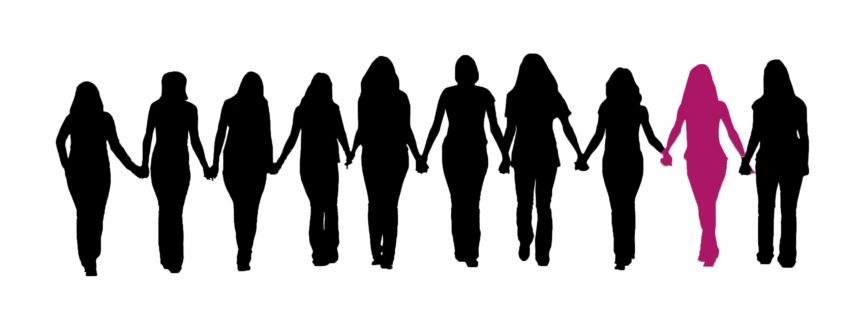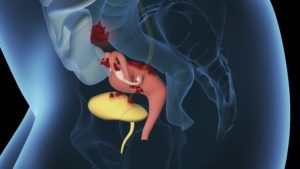Do you understand endometriosis? If not, it is time you did!
Endometriosis, a condition that impacts millions of women, often remains a mystery to many. While some may have heard of it, the specifics are frequently elusive. It is time we shed light on this common yet often misunderstood ailment. Endometriosis is more prevalent than you might think. If it were a political party and sufferers were voters, it would secure a place in parliament. Surprisingly, though, it remains relatively unknown. Many people have never encountered the term, and some healthcare professionals are not entirely familiar with its intricacies.
Yet, an estimated 10%-15% of women of childbearing age grapples with endometriosis – over 2 million women in Germany alone. Their quality of life takes a hit, and they endure the added burden of being ridiculed and dismissed. “Period pain? Do not overreact…”
You might know someone who becomes unreachable during their periods, abruptly cancels plans or misses work.

Approximately 1 in 10 women of childbearing age endure endometriosis.
The impact on well-being and quality of life can rival that of other chronic illnesses like cardiovascular diseases and certain cancers, and it predominantly affects women in their prime years. It robs them of the vitality they should enjoy at this life stage. Shockingly, they often face ridicule from society and even, regrettably, from some healthcare professionals. Some are sent home with a hot water bottle and a dismissive attitude.
I, too, knew little about endometriosis before I began my work at the Endometriosis Center of the University Hospital. I was utterly unaware of endometriosis before starting my medical studies!
Through conversations with friends, acquaintances, patients, and even strangers, I have realized that this lack of awareness is a shared experience for many. Even among healthcare practitioners, knowledge about endometriosis is often limited.
This status quo is untenable!
Where Does the Ignorance About Endometriosis Come From?
How can we ensure women with endometriosis are taken seriously?
The factors contributing to this issue are diverse, stemming from historical, societal, and health policy influences. For a deeper exploration, read on. However, let us now focus on the solution:
The pivotal first step is to ensure that everyone in our society understands what endometriosis entails. Knowledge about this challenging condition is the essential foundation for fostering greater empathy, garnering more support within communities and politics, advancing research efforts, increasing treatment accessibility – and ultimately, improving the lives of women dealing with endometriosis.
Devote just 5 minutes to acquaint yourself with endometriosis – women everywhere will be grateful!
So what should EVERYONE know about endometriosis?
If everyone knew these seven facts about endometriosis, we would be one step closer to better understanding women with endometriosis!
1. Endometriose verursacht Schmerzen – und es hat nichts mit normalen Regelschmerzen zu tun

Severe menstrual pain can be an indicator of endometriosis.
Menstrual discomfort is a normal part of a woman’s monthly cycle, typically characterized by uterine contractions that can be uncomfortable and cramp-like. Bloating often precedes this phase and is considered a regular occurrence. While it may
be unpleasant, it typically does not hinder you. Most women can continue their daily activities like shopping, working, or dancing at parties.
However, when women find themselves in the emergency room, dealing with severe period pain that causes fainting or has them curled up on the floor, there is often more to the story. In numerous instances, endometriosis is the underlying issue.
Endometriosis involves the abnormal growth of cells resembling the uterine lining in locations where they should not be, such as on the ovaries, within the abdomen, pelvic walls, the diaphragm, and even, albeit rarely, in the lungs.
While the exact origins of this condition are not yet fully understood, its effects are undeniable. It triggers inflammatory responses, invades other organs, and leads to hormone-related bleeding, resulting in pain and other symptoms.
It is important to note that not all women with endometriosis experience pain, but it remains the most common symptom associated with the condition.
2. The Comprehensive Impact of Endometriosis on Life

Severe pain frequently hinders women with endometriosis from engaging in social activities.
Endometriosis profoundly influences the lives of those affected, touching various aspects of their well-being.
Life during these times can be unbearable for women grappling with severe menstrual pain, often resulting in missed workdays and social events. Relationships can also bear the brunt, as routines often need to be adapted around the pain.
Many women face pain beyond their menstrual cycles, with some experiencing daily discomfort. Additional symptoms may include pain during sexual intercourse, overwhelming fatigue, digestive issues like bloating, a distended abdomen, discomfort during bowel movements, or pain during urination. Endometriosis can even impact the ureters and lead to kidney congestion. The presence of endometriosis near pelvic nerves may result in sensations of numbness, radiating pain, or a burning sensation.
In cases of deep infiltrating endometriosis, lesions can enter organs, potentially causing functional problems within those organs. For instance, the ovaries may be affected, leading to further complications.
.
3. Why Does It Take So Long to Diagnose?
The most significant contributing factor to delayed endometriosis diagnosis is widespread ignorance. Many women mistakenly perceive their pain as regular menstrual discomfort and assume they may have a lower pain threshold than their peers.
Moreover, some individuals prefer not to discuss their pain openly or only confide in their immediate family. Given the potential familial clustering (although endometriosis is not directly hereditary, families with multiple individuals with endometriosis are not uncommon), these symptoms may be perceived as “normal” compared to a mother who might be unaware of her condition.
Another hurdle arises when women seek medical attention from gynecologists or visit emergency rooms due to period-related pain and face ridicule. This often occurs due to a lack of understanding rather than malicious intent.
There is a pressing need for more extensive education to expedite the diagnostic process.

Women usually see many doctors before being diagnosed.
The diverse presentation of symptoms further complicates the diagnostic journey. Women typically consult multiple specialists before receiving a conclusive diagnosis. This occurs because endometriosis manifests symptoms that cross various medical disciplines. Consequently, comprehensive endometriosis centers often establish collaborations among gynecologists, colorectal surgeons, urologists, neurologists, and nephrologists to address the complexity of the condition.
4. Endometriosis Is Not a Mental Illness
Regrettably, there is a prevalent misconception shared by many, including some medical professionals, that endometriosis is a psychological or psychosomatic condition. However, this assumption is fundamentally incorrect.

Endometriosis typically spreads within the abdomen, where the cells closely resemble those found in the uterine lining.
Endometriosis primarily manifests within the abdominal region, where the cells closely resemble those found in the uterine lining. Endometriosis is characterized by the presence of cells that closely resemble those of the uterine lining. While their precise origin remains inconclusive, these cells typically develop within the abdomen, peritoneum, and abdominal organs. In rare cases, they may even occur outside the abdominal cavity, such as in the lungs, brain, or scars.
In these locations, endometriosis lesions trigger inflammation, pain, and functional impairments, resulting in symptoms dependent on their specific location.
Due to the presence of endometriosis lesions, repeated surgeries, adhesions, nerve involvement, and its protracted course, many women endure chronic pain. In essence, the brain learns to produce this pain independently of the initial stimulus – a well-researched and explained phenomenon for which psychological support can be beneficial. However, it is crucial to emphasize that this does not categorize endometriosis as a mental illness.
The prolonged suffering, combined with the aforementioned health and social constraints and limited treatment options, unfortunately, increases the likelihood of concurrent psychological disorders. Consequently, endometriosis may sometimes coexist with depression or other mental illnesses.
5. Endometriosis Complicates Pregnancies
Endometriosis ranks among the most common causes of infertility, underscoring the need for its thorough evaluation before embarking on fertility treatment. The exact mechanism behind this relationship continues to be the subject of ongoing research, but several factors appear to be at play. Factors such as an inflammatory environment, ovarian damage, and the formation of adhesions – particularly in the fallopian tubes – seem to contribute to fertility challenges in individuals with endometriosis.
An unfulfilled desire to have children can significantly impact one’s quality of life and strain relationships. However, it is essential to note that many women with endometriosis can still achieve their dream of becoming parents. Seeking guidance from professionals at specialized endometriosis and fertility centers can be invaluable for individuals with questions or concerns.
6. What Does Not Help: Belittlement, Excessive Pity, Platitudes, and Simplistic Advice

Women with endometriosis often receive well-intentioned but unhelpful, generalized advice.
Time and again, women dealing with endometriosis encounter well-intentioned advice such as:
- “It’s all in your head, try meditation.”
- “It’ll go away eventually!”
- “Just eat the right foods, and it will disappear!”
- “Think positively.”
While these suggestions may carry good intentions and contain elements of truth, they can inadvertently oversimplify the complexities of endometriosis.
Meditation, nutrition, and fostering positive emotions are essential factors in managing chronic pain, forming part of multimodal pain therapy that has shown promise. However, it is crucial to understand that addressing endometriosis is far from straightforward, and each woman’s journey requires an individualized approach and a deep well of understanding.
Consequently, seeking treatment at an endometriosis center with a personalized therapy plan is often the most effective path. Additionally, the most meaningful support from one’s social circle comes in the form of empathy and genuine understanding.
7. What Helps: Effective Medical Treatment and Empowering Self-Management
Let us begin with the good news: endometriosis is a treatable condition.

The gold standard for treatment involves surgical removal of endometriosis lesions, preferably through excision, typically performed via laparoscopy but occasionally requiring an abdominal incision. Additionally, hormone therapy can be beneficial in managing symptoms.
However, the challenging aspect of endometriosis is that it often follows a chronic course due to recurring lesions, incomplete surgery, or persistent pain.
Consequently, experts consistently recommend a multimodal approach to pain management from the outset of treatment.
This includes various strategies such as dietary adjustments, meditation, physiotherapy, massage therapy, and more, alleviating symptoms and fostering cognitive changes to improve chronic pain.
Achieving success in endometriosis therapy hinges on several crucial factors:
- Experienced Practitioners and Surgeons: All individuals with endometriosis must seek treatment at a certified endometriosis center and consult experts in the field. Certified endometriosis centers adhere to rigorous criteria and undergo independent audits, assuring patients of receiving care from trusted professionals.
- Active Management of Treatment: Given that discomfort may persist after or during treatment, and chronic pain is a common concern, women with endometriosis are encouraged to proactively educate themselves, participate in treatment decisions, and prioritize their well-being. Research has shown that this active involvement leads to the best possible outcomes.

In the realm of endometriosis treatment, the expertise of physicians and effective collaboration among various medical specialties are paramount!
Conclusion
Endometriosis is a common condition, and it is essential for both women and men, including yourself, to understand it. Even if you only read this section, here is what you should remember:
- Endometriosis is caused by cells that resemble those in the uterus lining. The exact source of these cells remains a subject of ongoing research.
- Severe pain, typically during menstruation, is the hallmark symptom of endometriosis.
- Endometriosis symptoms can manifest across multiple organs and areas, often significantly affecting a woman’s social and professional life. Understanding and empathy are crucial if a friend cancels plans due to a severe period pain.
- Endometriosis is frequently diagnosed later in life, making many women unaware of their condition.
- While endometriosis can affect mood and mental well-being, it is essential to clarify that it is NOT a psychological disorder. Women with endometriosis are not imagining their pain; they have a legitimate medical condition.
- Endometriosis can complicate pregnancies, making it essential to explore if infertility is a concern.
- Excessive pity, platitudes, trivialization, and simplistic advice are not helpful responses to endometriosis.
- What does help: Support and understanding from those around, seeking treatment at a specialized endometriosis center, and actively managing the condition and its treatment.
References
- Current Research on Endometriosis: An Interview with Deborah Bush - 6. February 2024
- Pain and Pain Management – Interview with Rehab Psychologist Teresa - 19. November 2023
- Physiotherapy for Endometriosis – Interview with Annika Cost – with Exercises - 19. November 2023


